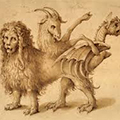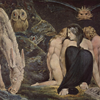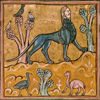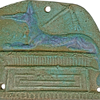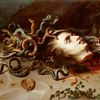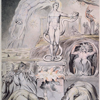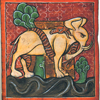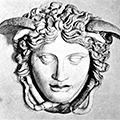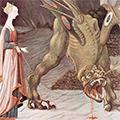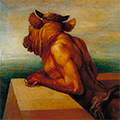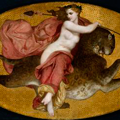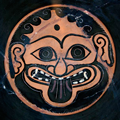Miguel Bernardo Olmedo Morell [*]
Abstract. In this essay, I will argue that The Legend of Zelda: Majora’s Mask has a threefold reading—that of the video-game plot, the traditional narrative, and the myth—that may branch off into multiple different narratives, depending on the player’s input. I will then look at how the self-fulfilling narrative of the game itself and those of the player as he controls Link can either run in parallel or clash at certain given points in order to produce these different narrative lines in the multiple iterations this game offers.
Keywords: Legend of Zelda, Majora’s Mask, zero-player games, video game narrative, mythological narrative
Resumen. En este ensayo argumentaré que The Legend of Zelda: Majora’s Mask tiene tres posibles lecturas (la de una trama de videojuego, la de la narrativa tradicional y la de la historia mítica) que, a su vez, se pueden subdividir en múltiples narraciones diferentes, dependiendo de las acciones del jugador. Estudiaré entonces cómo la narrativa de la trama que se resuelve a sí misma y las que resultan de las acciones del jugador cuando controla a Link pueden desarrollarse en paralelo o chocar en ciertos momentos para producir estas diversas líneas narrativas en las múltiples iteraciones que ofrece el juego.
Palabras clave: Legend of Zelda, Majora’s Mask, juegos de cero jugadores, narrativa de videojuegos, narrativa mitológica.
Videogame Narrative
The Game that Plays Itself
Dawn of the first day. 72 hours remain.
That is the initial message the player faces when he completes the prologue of the game and goes out of the Clock Tower into Clock Town. He has only three days to complete any adventure he may encounter because the moon is slowly yet steadily falling on the world. However, this time limit is way too demanding, and that is why the player is offered the option to «reset» the game by playing the Song of Time at any given moment. By doing so, any major items the player had received (such as masks or songs) will be kept, whereas numerically-dependent items will be set to 0 (such as rupees, arrows or bombs). That way, the player can reset the game as many times as he likes in his quest to stop the moon from falling and thus save the world.
But this is not the only innovative feature the game had at the moment. What’s really outstanding is that all the people the player may find during his travels have a very specific timetable (which can be accessed through an item named «Bomber’s Notebook», acquired early in the game). They’re not like every NPC (Non-Playable Character) in every RPG (Role-Playing Game) or action RPG before—where they are, what they do and what they say depends on when the player meets them. This makes the main city of the game, Clock Town, really come to life, because all these characters have their own lives, do whatever they are supposed to do and even interact with each other as if they were real people. This is why it can be said that this game plays itself: even if the player decided to spend the three whole days doing nothing—for instance, standing still on the entrance to the Clock Tower—time would still pass, every character would do what they’re supposed to do throughout that time, the narrative would still be fulfilled without any human input and, in the night of the third day, the moon would fall, causing the storyline to come to an end.
Game over.
This is much unlike most other games, which are player-triggered. This means that certain events won’t happen until the player goes somewhere or talks to someone. If he chooses to do nothing, the game will «freeze», everyone will stand in the same place forever and nothing will happen at all. In other words, these games can only be fulfilled and reach a conclusion (even if that conclusion is a «Game Over» screen) if the player performs certain actions. These are player-dependent games. I would argue, then, that The Legend of Zelda: Majora’s Mask should be treated as a new, fifth category to Jesper Juul’s zero-player games typology. Let me explain.
In his article on zero-player games, Jesper Juul (2012) argues that there are four types of videogames (setup-only games, such as Conway’s Game of Life; games played by AIs, such as computer Chess; solved games, such as Hex; and hypothetical games, such as StatBuilder) where human players are either not necessary or just relevant for the initial phase of the game. However, the narrative and procedural structure of The Legend of Zelda: Majora’s Mask is not covered by any of these distinctions, and should be treated as a fifth type, as the kind of narrative game that develops its own story without the player having anything to do with it.
It is my contention that this game was so innovative, and is still a fan favourite, because it is player-independent: no matter what you do, NPCs will go on with their lives. For instance, if you decide to do nothing on the night of the first day about the thief that steals the bomb bag from the old lady from the bomb shop, this theft will happen and that item won’t be for sale at the shop. However, this event will take place regardless of whether the player is there to witness it or not [1]. The consequences of this event on the game’s narrative can be discovered by visiting the bomb shop and hearing the old lady talk about how she had been mugged the previous day.
But even if you decide to interact with a number of the NPCs and thus affect their actions, you will never be able to interact with all of them in a single three-day iteration. It is not even a matter of time, but one of conflict. For instance, in the night of the third day, you can choose to give the item «Priority mail» to the town’s postman in order for him to deliver it. By doing so, he will have an encounter with Madame Aroma, the mayor’s wife, who will order him to leave the town and seek refuge—which was what he wanted—and as a reward he will give you the item «Postman’s hat». The player, however, may also choose to deliver the letter himself to Madame Aroma and, in doing so, he will receive a bottle, one of the most valuable items in the game—while leaving the postman in his office, crying as he waits for the moon to fall.
These two options are in conflict and cannot be resolved in a single iteration: the player will be forced to play this segment twice—by turning back time—in order to obtain the two items. However, what he does will have a big impact on the narrative and character development: delivering the mail directly to Madame Aroma will leave the postman weeping in his office, enchained by the bonds of duty he never allows himself to break, whereas letting him accomplish the task will set him on a cathartic path to overcoming his obsession with routine. This way, the choices the player makes depending on the timetables of the different characters heavily affect the storyline and have a number of different outcomes. This means that the narrative of the game will always be different in every three-day iteration—that is to say, every time the player turns back time and returns to the dawn of the first day. The following would be a rough representation of the parallel narratives that take place in every three-day cycle.
| Dawn of 1st Day Reset |
| Dawn of 1st Day Reset |
| Dawn of 1st Day Reset |
| Dawn of 1st Day Reset |
Traditional Narrative
One should not think, however, that the narrative resets itself completely every time the player turns back time. Sure, numerical and minor items disappear and the NPCs return to their three-day timetables, but this game does have an ending, a win state. In order for the player to advance the plot, he must collect major items, which are the only thing that lets him advance throughout the world and explore new areas. Curiously enough, you can access the final dungeon (the Clock Tower) since the very first iteration, that is, when the player actually begins the game, but you need to collect four masks by defeating the bosses in the four cardinal temples in order to be able to face the final boss, Majora itself. This idea is pretty well summarized in Lee Sherlock’s essay on The Legend of Zelda and Philosophy (Sherlock, in Cuddy 2012: 126):
The acquisition of these items, in its turn, will allow for the player to interact in new ways with the citizens of Clock Town and thus advance their particular narratives. The diagram from the last section could then be redesigned in the following manner:
This graphic shows a more traditional narrative, with an Aristotelian plot even: the story has a beginning, a middle and an end, with all of its events being consistently intertwined between each other. The game could then be interpreted as a traditional narrative, in terms of the events that occur in Link’s quest. In order to determine whether it does, let’s check Marie Laure-Ryan’s conditions for a sequence of events to be a narrative:
(2) This world must be situated in time and undergo significant transformations.
(3) The transformations must be caused by non-habitual physical events […]
(4) Some of the participants in the events must be intelligent agents who have a mental life and react emotionally to the states of the world.
(5) Some of the events must be purposeful actions by these agents […]
(6) The sequence of events must form a unified causal chain and lead to closure.
(7) The occurrence of at least some of the events must be asserted as fact for the storyworld.
(8) The story must communicate something meaningful to the audience (Ryan, in Herman 2014: 29).
The world of Majora’s Mask, Termina, is populated by all kinds of people, and the main character is a human himself—which fulfills condition (1). The time during which the events develop are the three days before the moon falls on Termina (2), which in itself is a non-habitual physical event which is threatening the life of everyone in the world (3). Many of the characters in the game have their own particular reactions to how this event affects them, such as the disbelief of the carpenter’s guild, the worry of Clock Town’s soldiers, the cowardice of the dojo swordmaster, etc. (4). The fact that the moon is going to fall on the world is the consequence of the main villain, Skull Kid, doing so through the power of the mask of Majora (5). As explained above, the game starts when Skull Kid assaults Link in the Lost Woods and takes his steed, and finishes when Link stops the moon from falling, every single step on his journey driving him closer to that end (6). All of these events are true in the storyworld, and none are depicted to be a dream, a tale, or any kind of delusion (7). There are many messages its audience could take from this game, such as the will to fight against even the direst circumstances, or the hope that, even after the greatest disaster, a new day will dawn (8).
Using Marie-Laure Ryan’s definition, we have proven that Majora’s Mask’s can be contemplated as a traditional narrative. In fact, I think Northrop Frye’s definition of the term «romance» could show how useful it is to describe the elements we find in this kind of gameplay:
Surely enough, Link, the main character, is superior in degree to other men in so far as he has been chosen to be the carrier of the Triforce of Courage, the sacred treasure of the Goddesses, because of his unmatched bravery. Despite his being human, he is able to do all sorts of marvelous actions, such as turn back time and transform into dead people by putting on their mask, and fights against all kinds of colossal monsters that never take him down, no matter how many slashes and blows Link receives on his journey. Due to these unnatural powers of his, and to the magical nature of the items that help him along the way—foremost of which are the nominal masks that were announced in the game’s title—it is not the difficult to see Link as an equal to Lancelot or Beowulf, the only difference in their stories being that of the medium chosen to tell them. To follow Espen Aarseth’s (1997) nomenclature, Majora’s Mask could be considered ergodic literature, whereas Beowulf or The Knight of the Cart are considered traditional literature.
Should the player choose to play the game in the manner shown in the above diagram (as opposed to just standing there waiting for the moon to fall), this game’s narrative will not be unlike that of the previous and following installments of the saga The Legend of Zelda, a story about how the hero Link sets forth to vanquish the forces of evil and save the world yet again. The imprecise passage of time would now be clarified thanks to these «affordances», the lack or possession of which would determine what is past, present and future. The beginning would be the moment when Link is assaulted by Skull Kid in the Lost Woods; the middle would be all the gameplay in between, with him visiting every cardinal temple in order to gain the necessary artifacts to confront Majora; and the end would be the moment when, after defeating Majora’s Wrath, Link stops the moon from falling and saves the world. Additionally, the player may choose to play only through the major events, skipping every sidequest, or he may dwell in each of them as much as he likes, thus creating different—customized, even—storylines in each of the three-day cycle iterations.
In Half-Real (2011), Jesper Juul sets out to create a definition of what makes games be games by dividing their content into «real rules», which establish the mechanics of the game (i.e. how it’s played) and «fictional worlds», which comprises the setting, plot, characters, etc. One of the distinctions he explains, that of progression games vs. games of emergence, could be useful to establish Majora’s Mask as a traditional video game, in the sense that we are exploring in this section. Let’s see why.
It is a game of progression, as opposed to the games of emergence. The latter are defined as «a small number of rules that combine and yield large numbers of game variations for which the players must design strategies to handle» (Juul 2011: 5). A perfect example of this would be chess: we have only 64 squares and 16 pieces per player, and no plot whatsoever is involved. However, the combinations this game offers are almost endless, and thus we can expect every single game of chess to be different to any other one we had played before. Progression games, on the other hand, are defined as the ones where «the player has to perform a predefined set of actions in order to complete the game» (idem).
This is the case in Majora’s Mask: the player has to advance from the beginning, where Skull Kid assaults Link in the forest, to the end, where Link stops the moon from falling down on Termina, by facing the multiple obstacles the game designers have put on his way: overcoming dungeons, defeating mighty foes, collecting masks, etc. If, in his progression through all these obstacles and towards the end goal of stopping the moon, Link fails (by losing all his hearts or letting time run out, for instance), he will face a «Game Over» screen—that is, a «fail state»; if, on the other hand, he is victorious and defeats the final boss, he will see the ending sequence and achieve a «win state». The only rules involved dictate how the player’s avatar will react to the game world, what kind of interaction he can have with it; in emergence games, these rules are the game itself.
Mythical Narrative
Like a Musical Score: The Mythical Path
We have now seen how the game can «play itself» to a conclusion without any player input, and we have also explained how many different, parallel narrative sequences can arise depending on how the player decides to spend the three days he is given, the major items he obtains on his quests being the only milestone to mark the progress in his adventure.
The richness in this kind of narrative is that the player is not playing a «straight» game, in the sense that he has to go forward from the beginning to the end, but rather that he has to replay some segments in order to get different results to certain situations. This is a kind of videogame narrative we are not used to see, that is extremely uncommon. But it still is not unfamiliar to us, and the players didn’t seem to have any problem with it in order to successfully play and complete The Legend of Zelda: Majora’s Mask at the time. How could that be, if the game was so innovative, if the structure was so new to the players? Claude Lévi-Strauss sheds some light on the matter:
We must not forget that the story of Majora’s Mask is, from beginning to end, a myth; namely, that of the Apocalypse. From the very start we are threatened with the menace of the moon falling on the earth, which will end all life in the world of Termina in three days’ time. Not only that, but the game mechanics of the masks convey a powerful mythological symbolism: as Campbell (2013: 27) said, «the mask motif indicates that the person you see is two people. He’s the one wearing the mask and he is the mask that’s worn—that is, the mask of the role». Quite accordingly, by putting on any of the 24 masks available, you can either take on a specific role—you can fulfill the postman’s duties by putting on the postman’s hat, you can talk to the undead soldiers of Ikana by putting on the captain’s hat, etc.—or even transform yourself into another person—into Darmani the Goron hero by putting on the Goron’s mask, into Mikau the Zora guitarist by putting on the Zora’s mask, etc. By using these different masks and taking on these multiple roles and identities, Link’s own personality dissolves in order to transform into the mythical hero, whose larger-than-life identity is bigger than that of any regular human—thus being able to accomplish deeds that no regular human could hope to do, namely, stopping the Apocalypse from happening.
In order to convey such a mythical story, no usual storytelling could do, and that’s why we have such a fragmented narrative of parallel storylines that should not just be read from left to right, but also vertically, in order to apprehend all the events that happen to every citizen in this world. That way, if we wanted to know all there is to know about, say, Anju the innkeeper’s life, we would have to replay the three days like this:
I call The Legend of Zelda: Majora’s Mask the game with a thousand narratives because, in order to fully understand the whole story, in order to know every character and every situation as well as possible, we have to replay the three days we are given time and again, choosing a different path in every iteration, while interpreting everything that happens to us along the way not in usual, straightforward narrative terms, but in a mythical way, connecting «bundles of events» that happened to us in the first iteration with others that happened in the third and the fifth, so that we may fully comprehend the Apocalypse myth we are facing.
In this, The Legend of Zelda: Majora’s Mask is unlike any other video game. When defining cybertexts (the kind of ergodic literature video games are grouped in), Espen Aarseth (1997: 2) says that
In this game, as opposed to most other games, Link can turn back time and take the paths not taken and hear the voices unheard. He can even know when and where all the major events are going to happen, by consulting the Bomber’s Notebook. This makes him omnipotent (since he can control time and take all the routes possible) and omniscient (since he knows exactly where to go, and when to do so). These qualities separate him from most video game main characters and likens him to mythical deities by means of narrative and procedural devices.
This mythological reading is useful not only because it helps us understand better the events of Termina, but also because it has a practical, in-game use as well. Some of the most important items in the game, around which everything, from plot to game mechanics, revolves, are the masks. These count as major items that cannot be lost when one resets the game, and some of them are in contingency and can only be found if the player resets and replays the three-day cycle. Every mask has its uses, from the merely trivial (Stone Mask) to the ones without which a win state cannot be achieved (Goron Mask, Zora Mask, etc.).
Curiously enough, when the hero, Link, acquires all the major items he needs to stop the villain, Skull Kid, from destroying the world, the mask of Majora ascends to the moon in order to crash it itself on the earth. Link, of course, follows it into the moon, where he finds a sunny green meadow, under a bright sun, where nothing but a big tree stands—the readers of Joseph Campbell will clearly recognise this image as the World Navel [2], the mythological centre of the world, akin to the Yggdrasil tree of the Norse mythology. The resemblance is carried on even further when we read that «the dome of heaven rests on the quarters of the earth, sometimes supported by four caryatidal kings, dwarfs, giants, elephants or turtles» (Campbell 2008: 34). Let’s not forget that this tree is located in the inside of the moon—which is in the sky, or heaven—which in turn is being held by the four giants that Link had summoned from the four cardinal points of Termina in order to prevent the end of the world.
By the foot of the tree, four little children run playfully, each of them wearing a terrible mask that covers their faces. If the player chooses to talk to them, they ask him to give them all their masks—an act very similar to that of the abandonment of the self and all its material possessions in Buddhism in order to achieve Nirvana. Each of the four children (it is important to emphasize the mythological importance of the number four as that of totality, as evidenced in Jung and Kerényi 2002: 19-21) will put the hero to a test, where he will have to brave four quite hard ordeals in order to get the ultimate prize: the Fierce Deity Mask. The name itself is quite telling: it is a «Deity», a mask that lets Link turn into a God. In other words, by arriving to the World Navel after many adventures through the cardinal points of the world, abandoning his material belongings and braving four ordeals, the player has been ascended from mere mortality to Godhood. This mask is so powerful that it lets him defeat any enemy, including the final boss, Majora, in a matter of seconds, thus proving through game mechanics what had already been implied by the plot.
This power, however, cannot be obtained if the player decides not to traverse all the possible different timelines, if he chooses not to know the world of Termina and its inhabitants from all the different points of view possible [3]. It is only through a mythological reading (horizontally as well as vertically) that the myth can be fulfilled and the player may ascend into Godhood, not as a mere mortal—as he would be through a normal gameplay—but as the messiah that, after sacrificing himself and his own identity—each mask transforms him into a different being—will save Termina from its doom, and lead it into the dawn of a new day.
It is also remarkable that this ascension to Godhood is achieved by an orphan child, which, according to Jung and Kerényi (2002: 29-82), would mean that Link fits into the mythologem of the primordial child, thus making him akin to Zeus, Apollo, Hermes and Dyonisus. This is especially notorious because of the aquatic nature of the game (three of the four dungeons of the game revolve around water: the poisoned swamp, the frozen mountain, and the great bay), which Jung and Kerényi, likening water to a womb, consider a crucial element in this kind of myths [4]. To carry this comparison of water and the womb even further, we may consider that, in the third segment of the game, Link has to actually brave the sea, dive through abyssal depths, and there rescue some eggs that have been stolen from a Zora (a fish-like race recurrent in the saga) mother. Another very important aspect of this kind of mythologem is the fact that the orphan child, despite being very small (or sometimes even a dwarf), can turn into a giant [5], which incidentally is what Link becomes able to do after he retrieves the Giant Mask from the Stone Tower Temple. We can see, then, that from a mythological narrative point of view, Link, the orphan child, is the perfect hero to traverse the whole of Termina, summon the giants and, journeying towards the World Navel and ascending to Godhood, redeem the world and save it from its imminent destruction.
Concluding remarks
To wrap thing up, we could conclude that, due to its three-day cycle and the possibility of traveling back in time, The Legend of Zelda: Majora’s Mask has a thousand different narratives that may vary depending on the player’s actions. At one end of the scale we have this game as a zero-player game, where it plays itself without any human input to its conclusion—namely, a lose state. On the other end we have the complete and all-encompassing mythological tale of the divine child who takes on the whole world upon himself (by means of identity-transforming masks) and, after overcoming multiple ordeals, ascends to divinity. Right in the middle we would have the common tale of a legend, of a hero superior in degree to other men and their environment who performs amazing feats of bravery and restores the world to its natural order. Depending on how many people Link helps and how many masks he acquires, the ending sequence will be different, showing the diverse effects the actions of the player have left in the world of Termina. We could establish, then, that each particular set of actions has different outcomes at the end of the game, which validates the theory of there being multiple narratives with different end sequences once the game is completed.
Such a rich and varied range of narratives would not have been possible were it not for the interactivity that characterizes videogames. It stands to reason, then, that not only do most videogames—with only a handful of exceptions to the rule, such as Tetris (1984) or Pacman (1980)—have narratives in the traditional sense of the word (we have applied concepts directly taken from literary theory to analyze it), as critics such as Jesper Juul have denied sometimes (Juul 1998), but they can also enhance and enlarge these by means of the exclusive characteristics of this medium.
It is my contention that this game has been a decisive milestone towards achieving the kind of dramatic narrative Janet H. Murray foresaw in Hamlet in the Holodeck (1997), the kind of narrative where the player’s actions, or lack of them, have a deep impact on the unfolding of the story and can completely change the way it is interpreted and felt by the player. Ideally, we will see more games that follow this pattern in the future, where NPCs are player-independent and a whole different set of outcomes are available to the player depending on the actions he decides to take or neglect, thus wholly exploiting the interactivity of the medium.
Bibliography
Aarseth, Espen (1997), Cybertext: Perpectives on Ergodic Literature. Baltimore, Maryland: The Johns Hopkins University Press.
Campbell, Joseph (2008), The Hero with a Thousand Faces. Novato, California: New World Library.
Campbell, Joseph (2013), Goddesses: Mysteries of the Feminine Divine. Novato, California: New World Library.
Frye, Northrop (2000), Anatomy of Criticism: Four Essays, with a new foreword by Harold Bloom. Princeton, New Jersey: Princeton University Press.
Gulik, Marcin (2015), «Eiji Aonuma Explains Whose Souls is in the Fierce Deity Mask», in Zelda Informer, 15th of March of 2015.
Herman, David (2014), The Cambridge Companion to Narrative. University of Cambridge: Cambridge University Press.
Jung, Carl Gustav & Kerényi, Karl. (2002), The Science of Mythology. Oxfordshire: Routledge.
Juster, Scott (2011), «Majora’s Mask», in Well Played 3.0: Video Games, Value and Meaning, 7th of May of 2011.
Juul, Jesper (2011), Half-Real: Video Games between Real Rules and Fictional Worlds. New York: The MIT Press.
& Staffan, Björk (1998), «A Clash between Game and Narrative», presented at the Digital Arts and Culture conference, Bergen, Norway.
Lévi-Strauss, Claude (2001), Myth and Meaning. Oxon: Routledge.
Murray, Janet H. (1997), Hamlet on the Holodeck. New York: The MIT Press.
Sherlock, Lee, in Cuddy, Luke (editor) (2012), The Legend of Zelda and Philosophy: I Link Therefore I Am. Chicago, Illinois: Open Court Publishing Company.
Ludography
Chess. Traditional, Board Game.
Hex. Parker Brothers, Board Game. 1952.
Game of Life. John Conway. Various computer platforms.
StatBuilder. Backburner Games. Flash. 2008.
The Legend of Zelda: Majora’s Mask, Prod. Shigeru Miyamoto, Dir. Eiji Aonuma & Yoshiaki Koizumi, Dev. Nintendo EAD, Nintendo, 2000.
Endnotes
[*] Universidad de Granada.
Contacto con el autor: miguelolmedo1988@gmail.com
[1] Scott Juster, in Well Played 3.0 (2011) neatly summarises what I have been explaining so far in the following quote:
[2] «The torrent [of the flow of life] pours from an invisible source, the point of entry being the center of the symbolic circle of the universe […] The tree of life, i.e., the universe itself, grows from this point» (Campbell 2008: 32).
[3] At the time of writing, this theory was still not proved. However, a few days before this article was published, Eiji Aonuma confirmed that the Fierce Deity mask contains all the memories of every single person living in the world of Termina, thus giving credibility to the theory put forward in this essay (Gulik 2015).
[4] «The child god, prototype of the wonderful orphan child, feeling quite at home in the primal element, reveals his full significance when the scene of his epiphany is water» (Jung and Kerényi 2002: 47), and also «The primal water conceived as the womb, the breast of the mother, and the cradle, is a genuinely mythological image, a pictorial unit packed with meaning» (idem: 55).
[5] «Kullervo was quite obviously neither ‘knee-high’ nor ‘a span in height’, but a giant […] There is a striking parallel to this giantism, which seems incompatible with the hero’s childhood, in another great mythology [the Hindu]» (Jung and Kerényi 2002: 47-48).



